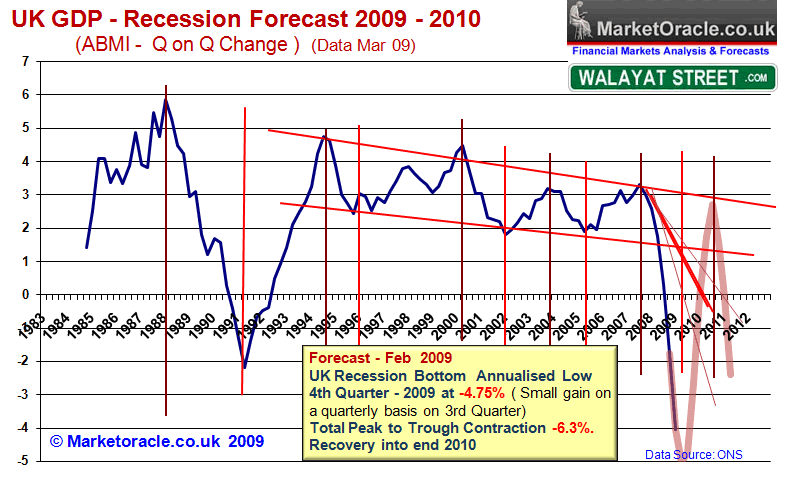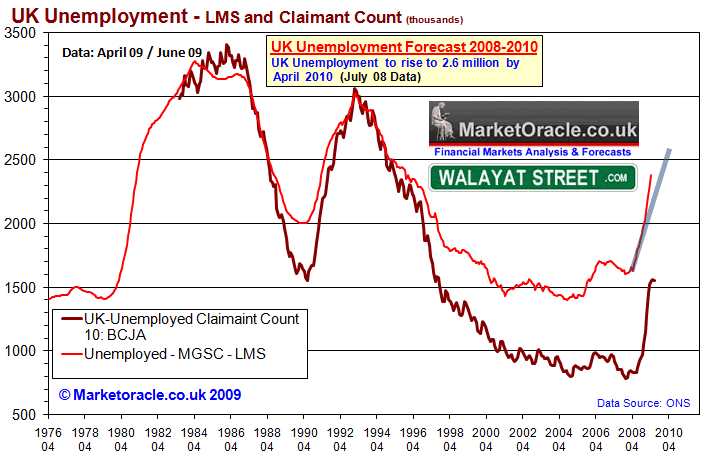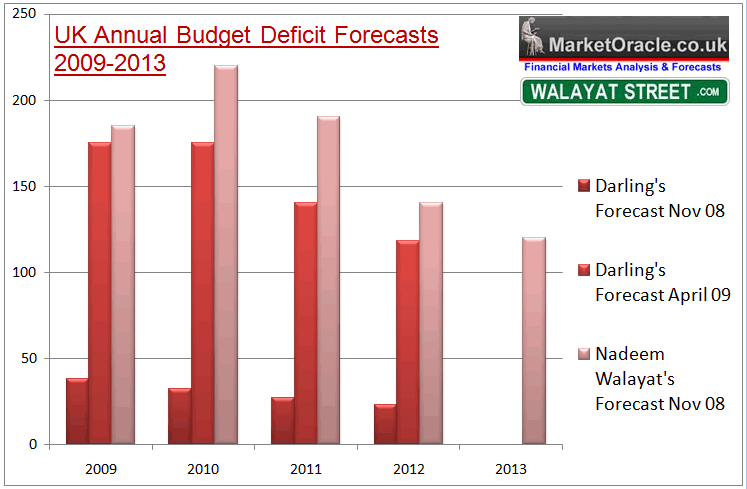Engineering a Strong UK Economic Recovery into a May 2010 General Election
ElectionOracle / UK General Election Jul 16, 2009 - 10:06 PM GMTBy: Nadeem_Walayat
 The big news from an economic prospective was the recent ONS revision to UK 1st Quarter GDP data from a contraction of -1.9% (April 09) to now -2.4% . The response in the mainstream media was virtually unanimous, shock and horror at the degree of contraction in the 1stQ which is the worst since 1958. However what the mainstream media have failed to comprehend is that the effect of a significantly lower 1st quarter GDP sets the scene for a lower base from which the economy can recover, as the NEXT FOUR quarters will show a GREATER BOUNCE in the data released in the run up to the May 2010 GENERAL ELECTION as I elaborate upon in this article.
The big news from an economic prospective was the recent ONS revision to UK 1st Quarter GDP data from a contraction of -1.9% (April 09) to now -2.4% . The response in the mainstream media was virtually unanimous, shock and horror at the degree of contraction in the 1stQ which is the worst since 1958. However what the mainstream media have failed to comprehend is that the effect of a significantly lower 1st quarter GDP sets the scene for a lower base from which the economy can recover, as the NEXT FOUR quarters will show a GREATER BOUNCE in the data released in the run up to the May 2010 GENERAL ELECTION as I elaborate upon in this article.
Engineering an Election 'Winning' Economic Recovery
The forecast date for the next General Election as of October 2007 has been for May 2010, with the projected seats implying a small Conservative victory of a majority of 36. Clearly all is not lost for the Labour government, therefore the primary aim now is to reduce this projected small majority by as much as possible if not to totally eliminate it, to achieve this the government has thrown ALL of the fiscally responsible rules out of the window starting last October having embarked on a programme of maximising the number of seats Labour will retain at the next general election. One of the key milestones set by the Prime Minister Gordon Brown of achieving this objective is in successfully and publically achieving a strong economic bounce into May 2010. My on going analysis confirmed a bounce into a May 2010 general election as long ago as February 2009, with more recent analysis confirming this outlook (UK Economy Set for Debt Fuelled Economic Recovery Into 2010 General Election)
The existing GDP forecast for the UK economy is for a bounce into late 2010 in advance of a double dip recession during 2011-2012 as the below graph illustrates.

The existing GDP quarterly projections are -
| GDP by Quarter | Quarterly | Annual |
| Q1 - 2009 - Published Late April 09 | -1.9% | -4.04% |
| Q2 - 2009 - Published Late July 09 | -1% | -5.05% |
| Q3 - 2009 - Published Late Oct 09 | -0.35% | -4.75% |
| Q4 - 2009 - Published Late Jan 09 | +0.6% | -2.65% |
| Q1 - 2010 - Published Late April 10 | +0.7% | -0.05% |
Therefore the economic forecast implies that the UK economy would just be emerging from recession on release of GDP data in April 2010, by recording 2 quarters of economic growth, however still recording negative GDP on an annual basis.
Impact of the amended first quarter GDP 2009 data to a contraction of -2.4% from -1.9% is:
| GDP by Quarter | Quarterly | Annual |
| Q1 - 2009 - Published Revised June 09 | -2.4% | -4.54% |
| Q2 - 2009 - Published Late July 09 | -.5% | -5.05% |
| Q3 - 2009 - Published Late Oct 09 | -0.35% | -4.75% |
| Q4 - 2009 - Published Late Jan 09 | +0.6% | -2.65% |
| Q1 - 2010 - Published Late April 10 | +0.7% | +0.45% |
The effect of the 1st quarter GDP revision is in effect to SHIFT 0.5% of contraction backwards and out of the total for the next 4 quarters and therefore give the economy a more significant implied bounce into a May 2010 General Election as illustrated by the above table that would show 2 quarters of economic growth + approx 0.5% of growth on an annual basis and therefore sending a clear signal to the electorate that the recession is over. There is also the chance of a further +0.5% to be SHIFTED into the period to 31st March 10 to give an even stronger perceived economic recovery just in time for the May election.
UK GDP data to be released later this month should confirm this revised GDP trend by recording a far smaller contraction for Q2 as indicated in the above table.
Unemployment
Unemployment is an extremely important element of the bounce back strategy, however the recent record surge in unemployment to 2.38 million is projecting towards a continuing sharp rise in unemployment towards mainstream consensus targets of between 3.2 million and 3.5 million. This is against my forecast of October 2008 (July 08 data) which forecast UK unemployment to hit 2.6 million by April 2010.

However as with the GDP data, we are seeing signs of the government attempting to engineer lower unemployment data (claimant count) in the most recent figures, those claiming job seekers allowance are actively being moved off of benefits onto programme's such as New Deal. Similarly the job less count whilst continuing to rise towards consensus ranges of upto 3.2 to 3.5 million. However I expect the peak in unemployment to come in significantly lower and much sooner than the mainstream are forecasting, i.e. to give several months of positive unemployment data into the May 2010 general election perhaps resulting in a rate declining to the original target of 2.6 million by April 2010 rather than the high mainstream projections -
Telegraph - The British Chambers of Commerce reiterated its forecast that unemployment will peak at 3.2m.
Guardian - The economy seems set to shed jobs well into 2010 and unemployment seems more likely than not to reach 3 million.
Swine Flu Spanner in the Works?
The press is running with headlines of 65,000 deaths accompanied with 1 in 8 of the work force off sick, IF anything near this materialises than this will impact on the economy, therefore probably negating the 0.5% GDP SHIFT to the 1st Q.
Politicians Hiding the Truth from the Electorate
Both main political parties continue to hide the truth of deep public spending cuts that will be forced onto the next government due to the huge amount of borrowing. The huge annual budget deficit of more than 12% of GDP ensures that the debt burden will continue increasing well past 2015, which demands extreme measures in the form of deep public sector spending cuts in an attempt to bring Britains finances back under control as the consequences of not doing so could result in a lost economic decade much as Britain experienced during the 1970's.

This debt fueled economic recovery will be followed by a severe second recession to rival that of the current recession in terms of GDP contraction of between 5% and 6% and which therefore implies a far worse outcome than the double dip recession that has in recent weeks begun to become the consensus expectation in the mainstream press, which I first referred to in February 2009.
My next in depth analysis will look at UK deflation / inflation and the prospects for UK Interest rates, to receive this in your email in box ensure your subscribed to my always FREE newsletter.
By Nadeem Walayat
http://www.marketoracle.co.uk
Copyright © 2005-09 Marketoracle.co.uk (Market Oracle Ltd). All rights reserved.
Nadeem Walayat has over 20 years experience of trading derivatives, portfolio management and analysing the financial markets, including one of few who both anticipated and Beat the 1987 Crash. Nadeem's forward looking analysis specialises on the housing market and interest rates. Nadeem is the Editor of The Market Oracle, a FREE Daily Financial Markets Analysis & Forecasting online publication. We present in-depth analysis from over 250 experienced analysts on a range of views of the probable direction of the financial markets. Thus enabling our readers to arrive at an informed opinion on future market direction. http://www.marketoracle.co.uk
Disclaimer: The above is a matter of opinion provided for general information purposes only and is not intended as investment advice. Information and analysis above are derived from sources and utilising methods believed to be reliable, but we cannot accept responsibility for any trading losses you may incur as a result of this analysis. Individuals should consult with their personal financial advisors before engaging in any trading activities.
Nadeem Walayat Archive |
© 2005-2022 http://www.MarketOracle.co.uk - The Market Oracle is a FREE Daily Financial Markets Analysis & Forecasting online publication.



